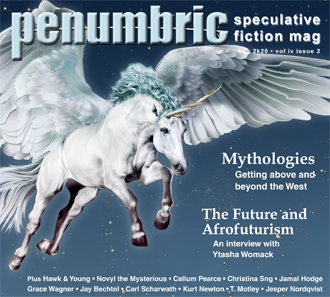From the Editor
by
Jeff Georgeson
previous next


full contents
article
Mythologies
From the Editor
by
Jeff Georgeson
previous

full contents
next

article
Mythologies
From the Editor
by
Jeff Georgeson
previous next


full contents
article:
Mythologies
previous

full contents
next

article
Mythologies
From the Editor by Jeff Georgeson
From the Editor
by Jeff Georgeson
Welcome to the second "modern" issue of Penumbric, wherein we explore just a little the stories and philosophical systems of cultures other than the ones with which we grew up--"we" in my particular case being a little blond-haired white kid out in the middle of America, but including a lot of other people out in those parts, or in America generally, or really in what is known as "the West" (which ironically excludes many of the people living there).
This "West" has been a dominant or dominating force in speculative fiction for many decades. Or has it? I guess it's a point-of-view thing; for those of us growing up here, who spent our adolescences reading Tolkien or Tolkien-inspired fantasy, for whom Asimov and Heinlein are the progenitors of our science fiction, and for whom one of many iterations of Bram Stoker's Dracula and Mary Shelley's Frankenstein have tickled us with horror, the West is dominant. But I imagine to someone growing up in India, or in China, or in Japan, or in Africa this is not so true, or at least may not be the overwhelming force it is here.
But as in many other fields, I think growing up within the West can be limiting. It's akin to our "travel problem" in the US: It's hard to get people here to travel anywhere but other places within the US; it's vast and dominant and familiar and cheaper to get to than anywhere outside it, and one doesn't really need to get out of one's comfort zone. But this leads to a lot of samey-samey vacations, to just sinking into the same fast food in every city, going on the same amusement park rides, going to the same store for the same fashions ...
In the same way I believe that people in the US ought to get out more to learn about other people and other ways of thinking, I believe our stories ought to reflect a range of influences, should be able to explore and share many cultures and values. And while I think this has happened more and more over time, I think the current backlash against anything "foreign" or "alien" (which is the unfortunate way the US labels anyone coming to visit, even legally) threatens that trend.
Our first article in this issue of Penumbric acts, I hope, as a primer for those who aren't particularly familiar with other cultural stories or who haven't thought of exploring them, for those who haven't thought about archetypes that connect our cultures and philosophies that can give rise to whole new ways of narrative thinking. It also emphasizes the need to not just appropriate or "use" other cultures' stories (another unfortunate Western heritage), but to really delve, to really understand what one is doing and what that culture's point of view is.
To be honest, I had a lot of trouble with this article. Twenty years ago I would have just blithely written a little tour guide of other stories and cultures, unaware of how it came across as though I were a 19th-century British anthropologist condescendingly describing the inhabitants nearby. Now I am much more aware, but my ability to write with this awareness feels sometimes lacking--I want to present everything with enthusiasm and respect, but I can still see it's from a very definite point of view, and I worry about that.
This article is followed by an interview with someone whose enthusiasm and respect for, as she calls them, the "wisdom systems" of other cultures and peoples is palpable and unabashed. Ytasha Womack is the author of Afrofuturism: The World of Black Sci-fi and Fantasy Culture, and we had an amazing discussion of her book, what it means to create Afrofuturist works, and the past, present, and future of those creations.
The rest of this issue came together in one of those synergistic and slightly mysterious ways that things do sometimes, for which I am grateful. There ended up being a sort of mythic theme to many of the works presented herein, including Hawk & Young's "Hadija," Callum Pearce's "Wings.," Jamal Hodge's "Oaths to Nihilism," Grace Wagner's "EMP," and Novyl the Mysterious's "Scion of War" (and of course James Cukr's cover art). But now that I start listing them, other works in the issue are tied in to myths or cultural stories in some way, including Christina Sng's "A Paradigm of Magic" and even "Metal Rain," and Jay Bechtol's "Fall," Novyl the Mysterious's other pieces, and even the pandemic-related "Feral Spring" by Kurt Newton.
I am pleased as well that the other work in this issue, while not "themed," is just as good: Carl Scharwath's "Double Vision" and the continuations of both Jesper Nordqvist's Mondo Mecho and T. Motley's The Road to Golgonooza.
So welcome to this second "modern" issue of Penumbric, and thank you so much for supporting us and the authors herein.











